Today is the feast day of St Guthlac the founder, or at least the holy man around whose grave there developed the commuity, of the abbey at Crowland ( Croyland) in Lincolnshire.
The remains of the abbey church are an enduring symbol of the destruction of the monasteries and all that went with that cataclysm. The north aisle of the nave survives as the parish church of the town. The remains are, I consider, profoundly evocative and deeply moving - a haunting image of a lost culture and way of life.
I have known the abbey remains from photographs since I was very young and have visited them on several occasions since I was about nine.
My reasearch on Bishop Fleming revealed that he had a connection with the abbey, acting as an arbitrator in along-running dispute involving the abbey and its claims, which is set out in the earlier continuation of the Croyland Chronicle ( not the more famous part with the account of the seizure of the throne by King Richard III in 1483).
John Dillon posted the following piece on the Medieval Religion discussion group about St Guthlac:
According to his earlier eighth-century Vita by a learned East Anglian monk named Felix (BHL 3723; c. 740 - available in a twentieth century translation by Bertram Colgrave), Guthlac was a Mercian warrior who underwent a religious conversion, spent two years at the monastery at Repton in today's Derbyshire, and then became an hermit in the East Anglian fens before establishing himself at Croyland, now spelled as Crowland, in Lincolnshire. Like the eremitically paradigmatic St. Anthony of Egypt, Guthlac is said to have been visited by angels and to have emerged victorious from repeated contests with demons. His death in 714 is recorded in the Anglo-Saxon Chronicle; in his entry s.v. "Guthlac" for the Oxford DNB Henry Mayr-Harting places it in the year 715. Still according to Felix, Æthelbald king of the Mercians while in exile spent time with the saint at Croyland before the latter's death and, returning to his oratory, received a vision of him; a year after Guthlac's death his sister St. Pega opened his grave, found his body to be incorrupt, and placed it in a memorial chapel; his relics operated miracles. Croyland Abbey (not shown to have existed before the tenth century) grew up at the site.
Today is Guthlac's feast day as recorded in the Old English Martyrology. It is also his feast day in the Church of England and his day of commemoration in the Roman Martyrology.
A view of the opening of Felix' Vita sancti Guthlaci in an eighth- or ninth-century copy formerly at St Augustine's, Canterbury (Cambridge, Corpus Christi College, MS 389, fol. 18r):
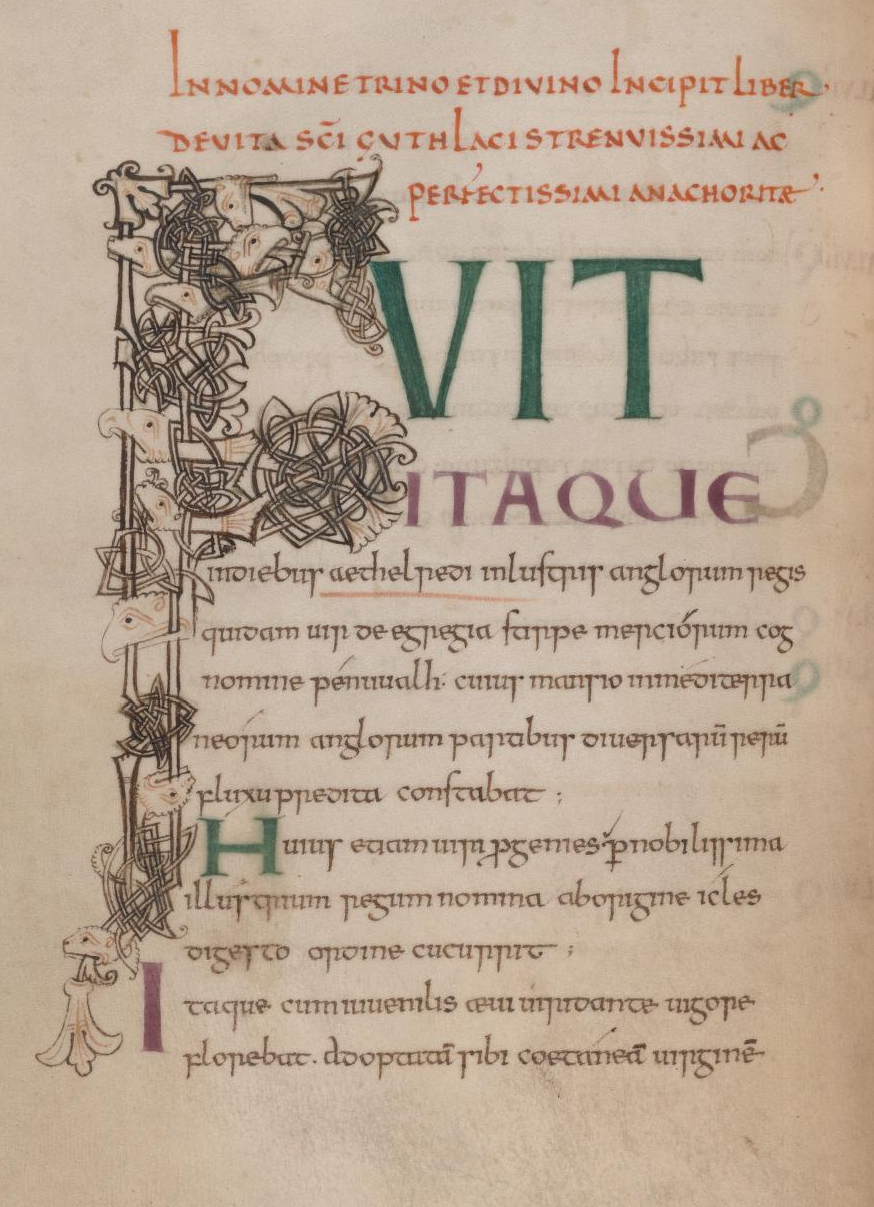
Two Old English poems preserved in the later tenth-century Exeter Book (Exeter Cathedral Library, MS 3501), "Guthlac A" and "Guthlac B", respectively recount aspects of the saint's heroic life and of his holy death. Aaron K. Hostetter's modern English-language translations of them are here ("Guthlac A"):
https://anglosaxonpoetry.camden.rutgers.edu/guthlac-a/
and here ("Guthlac B"):
http://anglosaxonpoetry.camden.rutgers.edu/guthlac-b/
An expandable view of the opening of an early twelfth-century copy of Felix' Vita sancti Guthlaci (1110; London, BL, Cotton MS Nero C VII, fol. 29v):

London, BL, Harley Roll Y6 (probably c. 1210), consists of eighteen roundels with engaging pen-and-ink drawings illustrating Guthlac's life and early cult. A brief, illustrated description is here:
The Guthlac Roll is also on display in the British Library’s newly refurbished Treasures Gallery.
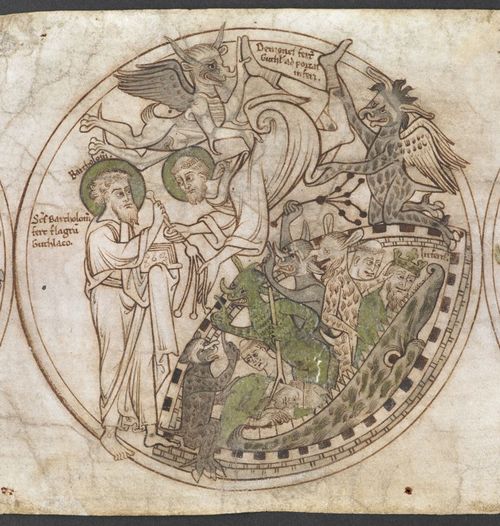
Drawing of Guthlac being carried to the gates of Hell by demons and being given a scourge by St Bartholomew with which to repel them, Harley Roll Y 6, roundel 8. For more Hell-mouths in BL manuscripts, see ‘Prepare to Meet Your Doom’.
The Guthlac Roll was made around the late twelfth or early thirteenth centuries. It is regrettably incomplete: a fifth piece of parchment, containing perhaps two or three roundels illustrating the earlier stages of his life, has been lost. What survives is a series of seventeen compelling and skilful pen-drawings in roundels of Guthlac’s life and deeds – including an entertaining trio illustrating his torment by and ultimate vanquishing of demons, aided by St Bartholomew – plus a final roundel illustrating the benefactors of his shrine at Crowland, in present-day Lincolnshire.
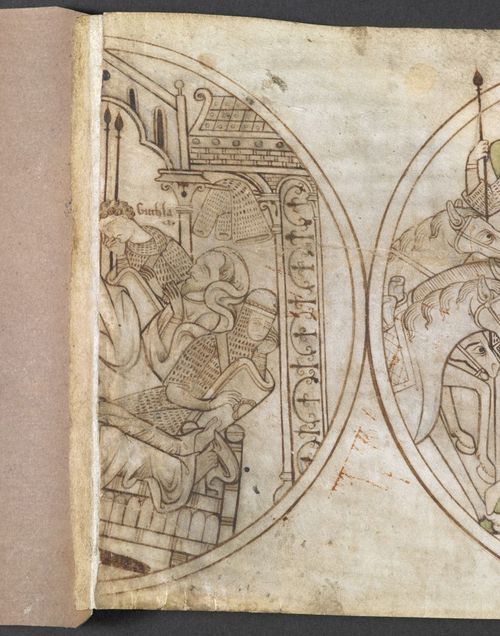
Drawing of Guthlac deciding to devote himself to a life of religion, Harley Roll Y 6, roundel 1 (incomplete).
Born into the Mercian royal dynasty, Guthlac spent his early adult life as a warrior, leading apparently successful raids and battles against hostile neighbouring tribes. The roll in its present state opens with half of a roundel that illustrates the sleepless night on which the young Guthlac, surrounded by his slumbering fellow-soldiers, resolved to devote himself to a life of religion.
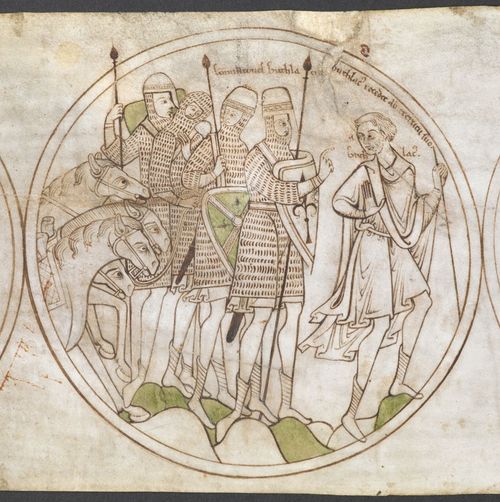
Drawing of Guthlac leaving military service, Harley Roll Y 6, roundel 2.
The roundel scenes are given particular animation by the skill with which the anonymous artist captured facial expressions. Note the bewilderment of Guthlac’s men as he bade them and the military life farewell. Stumped by his decision, they turn to one another questioningly; one looks down at the ground, seemingly lost in a moment of doubt. The soldier at the front appears to be appealing to Guthlac – but too late: his back turned, he is departing with a simple wave.
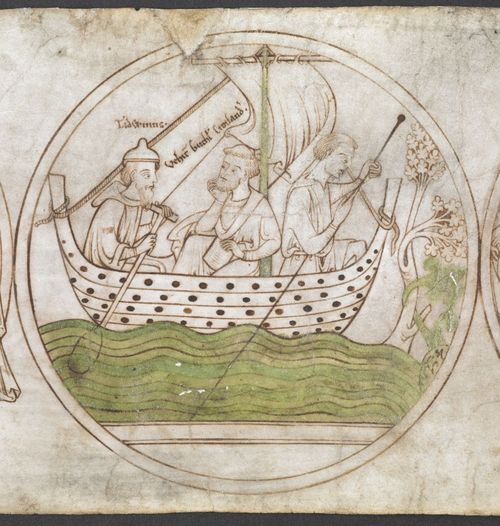

Drawing of Guthlac sailing to Crowland with Tatwin, Harley Roll Y 6, roundel 4.
Having received the tonsure at Repton Abbey, Guthlac set sail for Crowland, at that time an island amidst the Fens. The roundel shows that his life of contemplation had already begun: with an open book on his lap, his gaze tilted upwards, he is lost in thought, oblivious to the paddling of Tatwin and his helper
Drawing of Guthlac exorcising a demon from Ecgga, Harley Roll Y 6, roundel 10.
In a later roundel, two men look on in wonderment, one open-mouthed, as Guthlac is exorcising a demon from Ecgga. The scene reinforces Guthlac’s saintliness: that he possessed holy powers that were witnessed by his contemporaries.
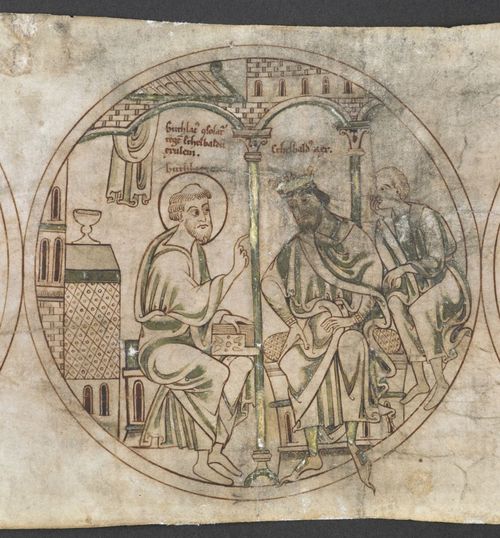
Drawing of Guthlac counselling Æthelbald, Harley Roll Y 6, roundel 12.
According to Felix of Crowland’s Vita Sancti Guthlaci, the main source for the roll, word of Guthlac’s deeds attracted wide attention. While in exile, Æthelbald, King of the Mercians, sought Guthlac’s advice. The artist depicted Æthelbald sitting with his eyes fixed upon Guthlac, listening intently to his teachi.
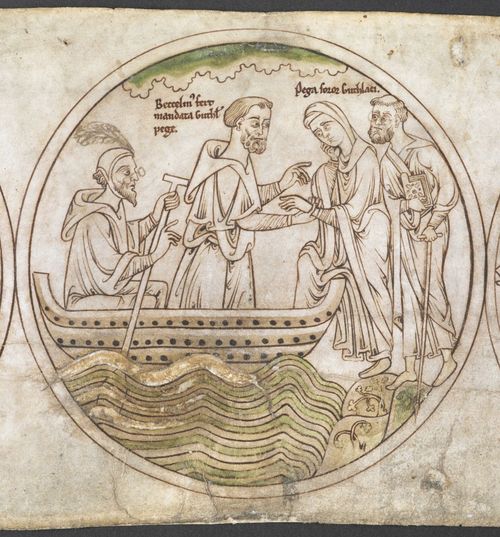
Drawing of Pega setting sail for Crowland with Beccelm, Harley Roll Y 6, roundel 15.
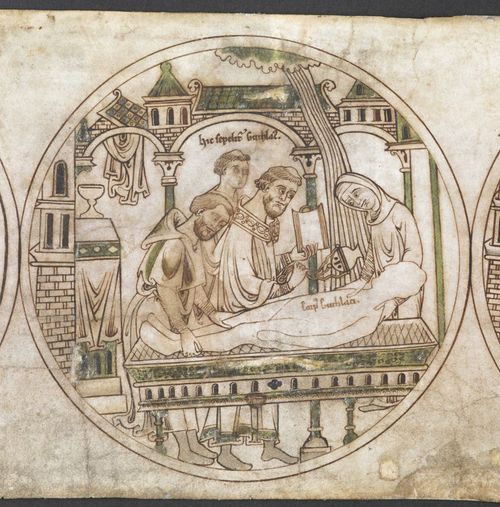
Drawing of Guthlac’s burial, Harley Roll Y 6, roundel 16.
The next roundel illustrates Guthlac’s burial. Observe the care with which one of the monks is holding Guthlac’s legs, how tenderly Pega is cradling the saint’s head in the crook of her arm, as they lower his shrouded body gently into the coffin. The depiction of Guthlac in silhouette – rather than wrapped in d
- See more at: http://britishlibrary.typepad.co.uk/digitisedmanuscripts/2014/04/on-a-roll.html#sthash.jjLWWkRH.dpuf
http://britishlibrary.typepad.co.uk/digitisedmanuscripts/2014/04/on-a-roll.htmlDrawing of Guthlac being carried to the gates of Hell by demons and being given a scourge by St Bartholomew with which to repel them, Harley Roll Y 6, roundel 8. For more Hell-mouths in BL manuscripts, see ‘Prepare to Meet Your Doom’.
The Guthlac Roll was made around the late twelfth or early thirteenth centuries. It is regrettably incomplete: a fifth piece of parchment, containing perhaps two or three roundels illustrating the earlier stages of his life, has been lost. What survives is a series of seventeen compelling and skilful pen-drawings in roundels of Guthlac’s life and deeds – including an entertaining trio illustrating his torment by and ultimate vanquishing of demons, aided by St Bartholomew – plus a final roundel illustrating the benefactors of his shrine at Crowland, in present-day Lincolnshire.
Drawing of Guthlac deciding to devote himself to a life of religion, Harley Roll Y 6, roundel 1 (incomplete).
Born into the Mercian royal dynasty, Guthlac spent his early adult life as a warrior, leading apparently successful raids and battles against hostile neighbouring tribes. The roll in its present state opens with half of a roundel that illustrates the sleepless night on which the young Guthlac, surrounded by his slumbering fellow-soldiers, resolved to devote himself to a life of religion.
Drawing of Guthlac leaving military service, Harley Roll Y 6, roundel 2.
The roundel scenes are given particular animation by the skill with which the anonymous artist captured facial expressions. Note the bewilderment of Guthlac’s men as he bade them and the military life farewell. Stumped by his decision, they turn to one another questioningly; one looks down at the ground, seemingly lost in a moment of doubt. The soldier at the front appears to be appealing to Guthlac – but too late: his back turned, he is departing with a simple wave.

Drawing of Guthlac sailing to Crowland with Tatwin, Harley Roll Y 6, roundel 4.
Having received the tonsure at Repton Abbey, Guthlac set sail for Crowland, at that time an island amidst the Fens. The roundel shows that his life of contemplation had already begun: with an open book on his lap, his gaze tilted upwards, he is lost in thought, oblivious to the paddling of Tatwin and his helper
Drawing of Guthlac exorcising a demon from Ecgga, Harley Roll Y 6, roundel 10.
In a later roundel, two men look on in wonderment, one open-mouthed, as Guthlac is exorcising a demon from Ecgga. The scene reinforces Guthlac’s saintliness: that he possessed holy powers that were witnessed by his contemporaries.
Drawing of Guthlac counselling Æthelbald, Harley Roll Y 6, roundel 12.
According to Felix of Crowland’s Vita Sancti Guthlaci, the main source for the roll, word of Guthlac’s deeds attracted wide attention. While in exile, Æthelbald, King of the Mercians, sought Guthlac’s advice. The artist depicted Æthelbald sitting with his eyes fixed upon Guthlac, listening intently to his teachi.
Drawing of Pega setting sail for Crowland with Beccelm, Harley Roll Y 6, roundel 15.
Drawing of Guthlac’s burial, Harley Roll Y 6, roundel 16.
The next roundel illustrates Guthlac’s burial. Observe the care with which one of the monks is holding Guthlac’s legs, how tenderly Pega is cradling the saint’s head in the crook of her arm, as they lower his shrouded body gently into the coffin. The depiction of Guthlac in silhouette – rather than wrapped in d
The Guthlac Roll is also on display in the British Library’s newly refurbished Treasures Gallery.

Drawing of Guthlac being carried to the gates of Hell by demons and being given a scourge by St Bartholomew with which to repel them, Harley Roll Y 6, roundel 8. For more Hell-mouths in BL manuscripts, see ‘Prepare to Meet Your Doom’.
The Guthlac Roll was made around the late twelfth or early thirteenth centuries. It is regrettably incomplete: a fifth piece of parchment, containing perhaps two or three roundels illustrating the earlier stages of his life, has been lost. What survives is a series of seventeen compelling and skilful pen-drawings in roundels of Guthlac’s life and deeds – including an entertaining trio illustrating his torment by and ultimate vanquishing of demons, aided by St Bartholomew – plus a final roundel illustrating the benefactors of his shrine at Crowland, in present-day Lincolnshire.

Drawing of Guthlac deciding to devote himself to a life of religion, Harley Roll Y 6, roundel 1 (incomplete).
Born into the Mercian royal dynasty, Guthlac spent his early adult life as a warrior, leading apparently successful raids and battles against hostile neighbouring tribes. The roll in its present state opens with half of a roundel that illustrates the sleepless night on which the young Guthlac, surrounded by his slumbering fellow-soldiers, resolved to devote himself to a life of religion.

Drawing of Guthlac leaving military service, Harley Roll Y 6, roundel 2.
The roundel scenes are given particular animation by the skill with which the anonymous artist captured facial expressions. Note the bewilderment of Guthlac’s men as he bade them and the military life farewell. Stumped by his decision, they turn to one another questioningly; one looks down at the ground, seemingly lost in a moment of doubt. The soldier at the front appears to be appealing to Guthlac – but too late: his back turned, he is departing with a simple wave.

Drawing of Guthlac sailing to Crowland with Tatwin, Harley Roll Y 6, roundel 4.
Having received the tonsure at Repton Abbey, Guthlac set sail for Crowland, at that time an island amidst the Fens. The roundel shows that his life of contemplation had already begun: with an open book on his lap, his gaze tilted upwards, he is lost in thought, oblivious to the paddling of Tatwin and his helper (who appears to be using a quant pole).
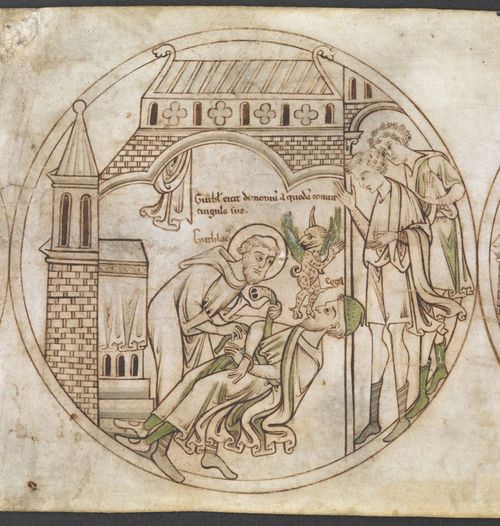
Drawing of Guthlac exorcising a demon from Ecgga, Harley Roll Y 6, roundel 10.
In a later roundel, two men look on in wonderment, one open-mouthed, as Guthlac is exorcising a demon from Ecgga. The scene reinforces Guthlac’s saintliness: that he possessed holy powers that were witnessed by his contemporaries.

Drawing of Guthlac counselling Æthelbald, Harley Roll Y 6, roundel 12.
According to Felix of Crowland’s Vita Sancti Guthlaci, the main source for the roll, word of Guthlac’s deeds attracted wide attention. While in exile, Æthelbald, King of the Mercians, sought Guthlac’s advice. The artist depicted Æthelbald sitting with his eyes fixed upon Guthlac, listening intently to his teaching, his attentive pose echoed by the rapt gaze of his attendant.

Drawing of Pega setting sail for Crowland with Beccelm, Harley Roll Y 6, roundel 15.
After Guthlac’s death, his sister Pega came to Crowland for his burial. The fifteenth roundel shows her, grief-stricken, being met by Guthlac’s disciple, Beccelm. Her brow is wrinkled, her eyes downcast; she is holding one hand up to her face mournfully. Her emotional state is echoed by her unsteady pose: with one foot on land and the other on the boat, she is balanced by Beccelm, who is lending her his hand.

Drawing of Guthlac’s burial, Harley Roll Y 6, roundel 16.
The next roundel illustrates Guthlac’s burial. Observe the care with which one of the monks is holding Guthlac’s legs, how tenderly Pega is cradling the saint’s head in the crook of her arm, as they lower his shrouded body gently into the coffin. The depiction of Guthlac in silhouette – rather than wrapped in dramatic loops and whorls of drapery as in the earlier death-bed scenes – was a deliberate artistic decision. It encapsulates the sudden absence of the central figure in this cycle of roundels and the emptiness of his mortal remains following the departure of his soul.
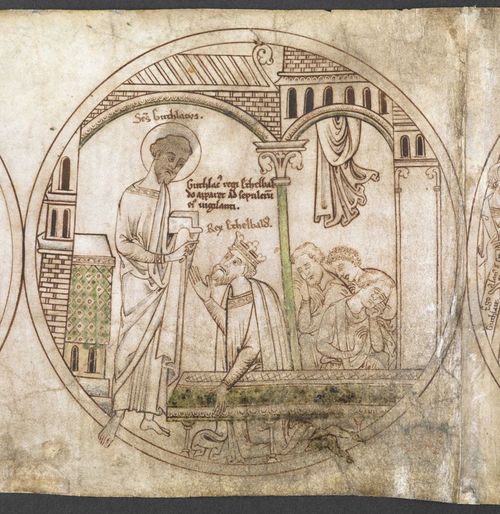
Drawing of Guthlac’s appearance in a vision to King Æthelbald during the vigil at his tomb, Harley Roll Y 6, roundel 17.
It also emphasises the miraculousness of Guthlac’s startling reappearance in the next roundel: standing before Æthelbald, who is now looking up in wonder at the newly designated saint.
It also emphasises the miraculousness of Guthlac’s startling
reappearance in the next roundel: standing before Æthelbald, who is now
looking up in wonder at the newly designated saint.Drawing of Guthlac being carried to the gates of Hell by demons and being given a scourge by St Bartholomew with which to repel them, Harley Roll Y 6, roundel 8. For more Hell-mouths in BL manuscripts, see ‘Prepare to Meet Your Doom’.
The Guthlac Roll was made around the late twelfth or early thirteenth centuries. It is regrettably incomplete: a fifth piece of parchment, containing perhaps two or three roundels illustrating the earlier stages of his life, has been lost. What survives is a series of seventeen compelling and skilful pen-drawings in roundels of Guthlac’s life and deeds – including an entertaining trio illustrating his torment by and ultimate vanquishing of demons, aided by St Bartholomew – plus a final roundel illustrating the benefactors of his shrine at Crowland, in present-day Lincolnshire.
Drawing of Guthlac deciding to devote himself to a life of religion, Harley Roll Y 6, roundel 1 (incomplete).
Born into the Mercian royal dynasty, Guthlac spent his early adult life as a warrior, leading apparently successful raids and battles against hostile neighbouring tribes. The roll in its present state opens with half of a roundel that illustrates the sleepless night on which the young Guthlac, surrounded by his slumbering fellow-soldiers, resolved to devote himself to a life of religion.
Drawing of Guthlac leaving military service, Harley Roll Y 6, roundel 2.
The roundel scenes are given particular animation by the skill with which the anonymous artist captured facial expressions. Note the bewilderment of Guthlac’s men as he bade them and the military life farewell. Stumped by his decision, they turn to one another questioningly; one looks down at the ground, seemingly lost in a moment of doubt. The soldier at the front appears to be appealing to Guthlac – but too late: his back turned, he is departing with a simple wave.
Drawing of Guthlac sailing to Crowland with Tatwin, Harley Roll Y 6, roundel 4.
Having received the tonsure at Repton Abbey, Guthlac set sail for Crowland, at that time an island amidst the Fens. The roundel shows that his life of contemplation had already begun: with an open book on his lap, his gaze tilted upwards, he is lost in thought, oblivious to the paddling of Tatwin and his helper (who appears to be using a quant pole).
Drawing of Guthlac exorcising a demon from Ecgga, Harley Roll Y 6, roundel 10.
In a later roundel, two men look on in wonderment, one open-mouthed, as Guthlac is exorcising a demon from Ecgga. The scene reinforces Guthlac’s saintliness: that he possessed holy powers that were witnessed by his contemporaries.
Drawing of Guthlac counselling Æthelbald, Harley Roll Y 6, roundel 12.
According to Felix of Crowland’s Vita Sancti Guthlaci, the main source for the roll, word of Guthlac’s deeds attracted wide attention. While in exile, Æthelbald, King of the Mercians, sought Guthlac’s advice. The artist depicted Æthelbald sitting with his eyes fixed upon Guthlac, listening intently to his teaching, his attentive pose echoed by the rapt gaze of his attendant.
Drawing of Pega setting sail for Crowland with Beccelm, Harley Roll Y 6, roundel 15.
After Guthlac’s death, his sister Pega came to Crowland for his burial. The fifteenth roundel shows her, grief-stricken, being met by Guthlac’s disciple, Beccelm. Her brow is wrinkled, her eyes downcast; she is holding one hand up to her face mournfully. Her emotional state is echoed by her unsteady pose: with one foot on land and the other on the boat, she is balanced by Beccelm, who is lending her his hand.
Drawing of Guthlac’s burial, Harley Roll Y 6, roundel 16.
The next roundel illustrates Guthlac’s burial. Observe the care with which one of the monks is holding Guthlac’s legs, how tenderly Pega is cradling the saint’s head in the crook of her arm, as they lower his shrouded body gently into the coffin. The depiction of Guthlac in silhouette – rather than wrapped in dramatic loops and whorls of drapery as in the earlier death-bed scenes – was a deliberate artistic decision. It encapsulates the sudden absence of the central figure in this cycle of roundels and the emptiness of his mortal remains following the departure of his soul.
Drawing of Guthlac’s appearance in a vision to King Æthelbald during the vigil at his tomb, Harley Roll Y 6, roundel 17.
It also emphasises the miraculousness of Guthlac’s startling reappearance in the next roundel: standing before Æthelbald, who is now looking up in wonder at the newly designated saint.
- James Freeman
- See more at: http://britishlibrary.typepad.co.uk/digitisedmanuscripts/2014/04/on-a-roll.html#sthash.jjLWWkRH.dpufand a complete digitisation starts here:
http://www.bl.uk/manuscripts/Viewer.aspx?ref=harley_roll_y_6_fs001r
The Clever Boy has seen the argument - and it seems a very reasonable one - that these are designs for stained glass to decorate the abbey.
Gordon Plumb added the following photographs of the west doorway tympanum at Crowland, four scenes of the life of St Guthlac:
and
details:
https://www.flickr.com/photos/22274117@N08/11350859623

The nave of Crowland Abbey today
Image: richardiiiworcs.co.uk
A modern reconstruction of the abbey in its last years as a monastery
Image:crowlandabbey.org.uk


No comments:
Post a Comment